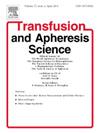Laboratory measurement of autoantibodies to Annexin A1: Review and measurements in health and COVID-19
IF 1.4
4区 医学
Q4 HEMATOLOGY
引用次数: 0
Abstract
Annexin A1, a protein released by neutrophils, is a potent regulator of inflammation in the intact form, but loses this activity when cleaved. The presence of autoantibodies to this protein can impact its function. An immunoassay, developed to measure autoantibodies to Annexin A1 in plasma or serum, has been developed and performances are reported. The cut-off for the positive range is determined from the mean value and standard deviations measured in a healthy group. Anti-Annexin A1 autoantibodies were then tested in hospitalized COVID-19 patients, at baseline or at any time during hospitalization. Sixty-one out of 379 patients tested positive for at least one isotype, IgG, IgA, or IgM. Few patients presented with only 1 isotype (2 G, 12 A, 16 M), but the combination of 2 isotypes was observed in many of them, and 3 expressed the 3 isotypes all together. Some association was noted between the presence of these autoantibodies and the development of thrombosis or admission in Intensive Care Units. The specific clinical complication risk associated to each isotype is yet to be established as our study was mainly transversal. Complementary studies are required to better evaluate the diagnostic or prognostic values of the anti-Annexin A1 autoantibodies, which have already been reported in various clinical situations. They could potentially reduce the anti-inflammatory regulation potential of Annexin A1, a mechanism which could contribute to disease evolution and worsening.
附件蛋白 A1 自身抗体的实验室测量:健康和 COVID-19 的回顾与测量。
Annexin A1 是一种由中性粒细胞释放的蛋白质,在完整形态下是一种有效的炎症调节剂,但在裂解后就失去了这种活性。这种蛋白质自身抗体的存在会影响其功能。目前已开发出一种免疫测定方法,用于测量血浆或血清中附件蛋白 A1 的自身抗体,并报告了其性能。阳性范围的临界值是根据健康人群中测得的平均值和标准偏差确定的。随后,对 COVID-19 住院患者的抗附件蛋白 A1 自身抗体进行了基线或住院期间任何时间的检测。在 379 名患者中,有 61 人至少有一种同工酶型(IgG、IgA 或 IgM)检测呈阳性。少数患者只有一种同种型(2 个 G、12 个 A、16 个 M),但许多患者同时出现了两种同种型,其中有 3 名患者同时出现了三种同种型。这些自身抗体的存在与血栓形成或入住重症监护病房之间存在一定的关联。由于我们的研究主要是横向的,因此与每种异型相关的具体临床并发症风险还有待确定。需要进行补充研究,以更好地评估抗附件素 A1 自身抗体的诊断或预后价值。抗附件蛋白 A1 自身抗体可能会降低附件蛋白 A1 的抗炎调节潜能,这种机制可能会导致疾病的演变和恶化。
本文章由计算机程序翻译,如有差异,请以英文原文为准。
求助全文
约1分钟内获得全文
求助全文
来源期刊
CiteScore
3.60
自引率
5.30%
发文量
181
审稿时长
42 days
期刊介绍:
Transfusion and Apheresis Science brings comprehensive and up-to-date information to physicians and health care professionals involved in the rapidly changing fields of transfusion medicine, hemostasis and apheresis. The journal presents original articles relating to scientific and clinical studies in the areas of immunohematology, transfusion practice, bleeding and thrombotic disorders and both therapeutic and donor apheresis including hematopoietic stem cells. Topics covered include the collection and processing of blood, compatibility testing and guidelines for the use of blood products, as well as screening for and transmission of blood-borne diseases. All areas of apheresis - therapeutic and collection - are also addressed. We would like to specifically encourage allied health professionals in this area to submit manuscripts that relate to improved patient and donor care, technical aspects and educational issues.
Transfusion and Apheresis Science features a "Theme" section which includes, in each issue, a group of papers designed to review a specific topic of current importance in transfusion and hemostasis for the discussion of topical issues specific to apheresis and focuses on the operators'' viewpoint. Another section is "What''s Happening" which provides informal reporting of activities in the field. In addition, brief case reports and Letters to the Editor, as well as reviews of meetings and events of general interest, and a listing of recent patents make the journal a complete source of information for practitioners of transfusion, hemostasis and apheresis science. Immediate dissemination of important information is ensured by the commitment of Transfusion and Apheresis Science to rapid publication of both symposia and submitted papers.

 求助内容:
求助内容: 应助结果提醒方式:
应助结果提醒方式:


